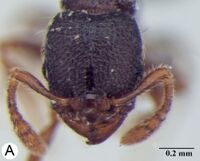Vollenhovia pfeifferi
| Vollenhovia pfeifferi | |
|---|---|

| |
| Scientific classification | |
| Kingdom: | Animalia |
| Phylum: | Arthropoda |
| Class: | Insecta |
| Order: | Hymenoptera |
| Family: | Formicidae |
| Subfamily: | Myrmicinae |
| Tribe: | Crematogastrini |
| Genus: | Vollenhovia |
| Species: | V. pfeifferi |
| Binomial name | |
| Vollenhovia pfeifferi Bharti, Dhadwal & Rilta, 2023 | |
This apparently rare species is only known from 2 collections made in India.
Photo Gallery
Identification
Dhadwal, Rilta and Bharti (2023) - This species resembles Vollenhovia mawrapensis but can be easily distinguished from it by a combination of the following characteristics: in V. pfeifferi head distinctly longer than broad (CI 77.14-91.07), mandibles with 6-teeth, propodeum with a pair of small denticles, subpetiolar process, subtriangular with anterior face rounded, pronotum and mesonotum reticulate rugulose and densely punctated, dorsal surface of first gastral tergite sparsely punctated up to the middle of tergite and remaining gastral tergites smooth and shiny. Whereas in Vollenhovia mawrapensis head is as long as broad (CI 89.58-91.66), mandibles with 7-teeth, propodeal corners rounded without denticles, subpetiolar process, elongate and rectangular, pronotum and mesonotum longitudinally rugulose and densely punctated, dorsal surface of first gastral tergite coarsely punctated and remaining gastral tergites with piligerous punctures.
Keys including this Species
Distribution
Akbar et al. (2023) report a second locality for this taxon of the Western Ghats, based on samples collected in the Periyar Tiger Reserve.
Latitudinal Distribution Pattern
Latitudinal Range: 9.5° to 9.5°.
| North Temperate |
North Subtropical |
Tropical | South Subtropical |
South Temperate |
- Source: Dhadwal et al., 2023
Distribution based on Regional Taxon Lists
Oriental Region: India (type locality).
Distribution based on AntMaps
Distribution based on AntWeb specimens
Check data from AntWeb
Countries Occupied
| Number of countries occupied by this species based on AntWiki Regional Taxon Lists. In general, fewer countries occupied indicates a narrower range, while more countries indicates a more widespread species. |

|
Estimated Abundance
| Relative abundance based on number of AntMaps records per species (this species within the purple bar). Fewer records (to the left) indicates a less abundant/encountered species while more records (to the right) indicates more abundant/encountered species. |

|
Biology
Castes
Nomenclature
The following information is derived from Barry Bolton's Online Catalogue of the Ants of the World.
- pfeifferi. Vollenhovia pfeifferi Bharti, Dhadwal & Rilta, in Dhadwal et al., 2023: 4, figs. 7-9 (w.) INDIA (Kerala).
Unless otherwise noted the text for the remainder of this section is reported from the publication that includes the original description.
Description
Worker
Holotype: HL 0.57; HW 0.51; SL 0.34; EL 0.12; ML 0.60; PRNW 0.42; PTL 0.21; PPTL 0.18; PTW 0.20; PPTW 0.22; PTH 0.23; PPTH 0.21; GL 0.78; TL 2.34 mm; CI 89.47; SI 66.66. Paratypes: HL 0.56-0.70; HW 0.51-0.54; SL 0.34-0.38; EL 0.12-0.13; ML 0.60-0.62; PRNW 0.39-0.42; PTL 0.19-0.22; PPTL 0.18-0.19; PTW 0.18-0.20; PPTW 0.21-0.22; PTH 0.22-0.24; PPTH 0.20-0.21; GL 0.78-0.92; TL 2.31-2.65 mm; CI 77.14-91.07; SI 66.66-70.37 (n=5).
In full-face view, the head is distinctly longer than broad (CI 77.14-91.07), the posterior head margin slightly concave in the middle, occipital corners rounded, lateral margin almost straight; head as broad anteriorly as posteriorly; clypeus broad, anterior margin convex; mandibles triangular, masticatory margin with 6-teeth; antennae 12-segmented, with a club of an apical 3-larger segment, scape short and falling short of reaching posterior head; eyes small and placed laterally below the mid-length of the head. In dorsal view, mesosoma trapezoidal; promesonotal suture indistinct; metanotal groove weakly developed; propodeal declivity weakly concave medially and laterally emarginated; petiolar node as long as broad; postpetiole broader than long; gaster subglobose.
In lateral view, the mesosoma is feebly convex; posterodorsal corners of propodeum bluntly angulate, having small denticles; propodeal lobe subtriangular; petiolar node subrectangular with anterior margin straight and posterior margin slightly concave; subpetiolar process, subtriangular with anterior face rounded; postpetiole node as long as broad.
Head with large and coarse punctures; a narrow, smooth band extended up to the middle of eyes; clypeus smooth and with divergent carinae; mandibles smooth; pronotum and mesonotum reticulate rugulose and densely punctated; punctures on propodeum small and declivity transversely striated; laterally mesosoma coarsely punctated; petiole and postpetiole reticulate rugose; dorsal surface of first gastral tergite sparsely punctated up to the middle of tergite and remaining gastral tergites smooth and shiny.
Body covered with dense erect and sub-erect hairs; appressed pubescence sparse on the body but dense on antennae and appendages.
Head, mesosoma, and gaster brown in color; mandibles, antennae, and appendages reddish yellow.
Type Material
- Holotype worker: India: Kerala, Parambikulum Tiger Reserve, Karimala, 900 m, 9.5538°N, 77.0610°E, 2.vii.17 (Holotype - PUAC T717; Paratype - PUAC T720-T724).
- Paratype, 5 workers, same data as holotype. Handpicking method. Tarun Dhadwal leg.
Etymology
The species is named in honor of Dr. Martin Pfeiffer, Senior scientist at the Department for Biogeography, University of Bayreuth, Germany, for his significant contributions to the field of Ant ecology and biogeography.
References
- Akbar, S. A., Bharti, H., Schifani, E., Wachkoo, A. A. 2023. Overview of the ant genus Vollenhovia (Hymenoptera, Formicidae) in India and Sri Lanka, with an illustrated key and the description of a new species. European Journal of Taxonomy 908, 77-107 (doi:10.5852/ejt.2023.908.2339).
- Dhadwal, T., Rilta, J. S., Bharti, H. 2023. Taxonomic studies on the genus Vollenhovia Mayr, 1865 (Hymenoptera: Formicidae): Five new species from India. Sociobiology 70(3), e9103 (doi:10.13102/sociobiology.v70i3.9103).



